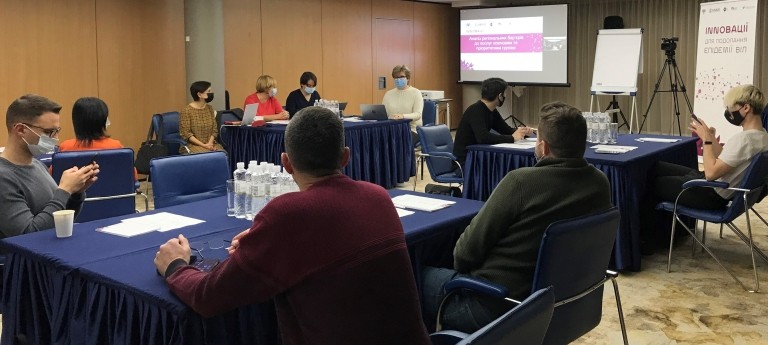Blog
In Ukraine, HIV service monitors deliver critical data to improve care amid war

Interviews in one city revealed that almost no information was available about PrEP, a medication for HIV prevention. In another city, informants told of long wait lists and limited information about medication-assisted treatment (MAT) for people struggling with drug addiction.
Once these problems were uncovered, the information went to Ukraine’s Ministry of Health Center for Public Health. The information allowed officials to take action, and improved services became available.
This was made possible through HIV service monitoring that began under the Community Action for HIV Control project. Led by Pact and funded by USAID and PEPFAR, the project is accelerating Ukraine’s efforts to achieve HIV epidemic control by 2030 through improved prevention, testing and linkages to care among key populations.
HIV service monitoring is the project’s bedrock. Launched in April, shortly after Russia’s full-scale, unjustified invasion of Ukraine, the monitoring involves detailed data collection about HIV services across the country. But it is also much more than that. The main purpose is to deliver information regarding barriers to HIV services directly from key populations to the Public Health Center, the organization that can undertake managerial actions to eliminate the barriers. All the data is collected and transmitted to the project in real time by monitors who are key population representatives and have close links with their communities.
“Monitoring doesn’t just gather feedback from service recipients. It helps to improve service provision,” says Pact’s Iryna Gryshayeva, the project’s enabling environment and policy advisor. “It is also strengthening key populations’ capacities to advocate for their rights and better services.”
Some HIV service sites have been destroyed because of the war, and medical professionals and patients have moved to find safety. These disruptions have made monitoring even more critical.

The monitoring is carried out by 15 specially trained consultants who are located in monitoring cities and have access to representatives of key populations who receive or wish to receive HIV-related services. These key populations include people who inject drugs (PWID), sex workers (SW), men having sex with men (MSM) and former prisoners. The monitors either know the informants personally, or they find them through other community members or at places where they receive services.
The monitors conduct structured interviews according to a specially developed guide, gathering information to identify barriers affecting the provision of HIV testing, PrEP (pre-exposure prophylaxis), antiretroviral therapy, methadone-assisted therapy, hepatitis C or B testing and treatment, and more. Monitors have also asked about the humanitarian needs of key populations caused by Russia’s invasion of Ukraine and the ongoing war. Monitors work in 24 cities across 14 oblasts plus the city of Kyiv, and they have the ability to solve some issues on the spot with local medical facilities, doctors and NGO leaders.
Extremely important in the process is the Center for Public Health, which responds to feedback from key communities and uses the monitoring results to make management decisions. For cities located in frontline areas or those occupied by Russia, this mechanism is the only one that works.
Because of the war, some HIV service sites have been destroyed. Medical professionals and patients have moved to find safety. Because of these disruptions, monitoring is even more critical, Gryshayeva notes.
Velta Parkhomenko, a monitor in Kyiv, says that monitors’ work has built trust between officials and key populations they are working to reach.
“At the beginning of the monitoring, people were less motivated to provide information. They did not believe that their answers could change anything.” Now that they have seen results, “representatives of key populations have been providing information more readily.”
Olexiy Kvitkovskyi, a monitor from Zaporizhzhia, says the actions that have been taken based on monitoring data are making all the difference.
“It enables us to see the bigger picture. Most importantly, we are witnessing how this process saves the health and improves the lives of community members.”